Loughborough Autumn AGS Show, 2012
It is always a delight to visit the autumn show at Loughborough. Located in the heart of England, it unfailingly brings together plants and their owners from far and wide. This year was no exception, the benches carrying a wide range of plants brought by 60 exhibitors, including 11 in the Novice Section, which bodes well for the future. As expected at this time of year, autumn-flowering bulbs provided the bulk of colour and interest, but many other plants drew attention, including a good range of shrubs, some exhibited primarily for their autumn colour, others for their fruit, and many sempervivums and expertly grown cushion plants, showing once again the importance of form and substance in alpine gardening.
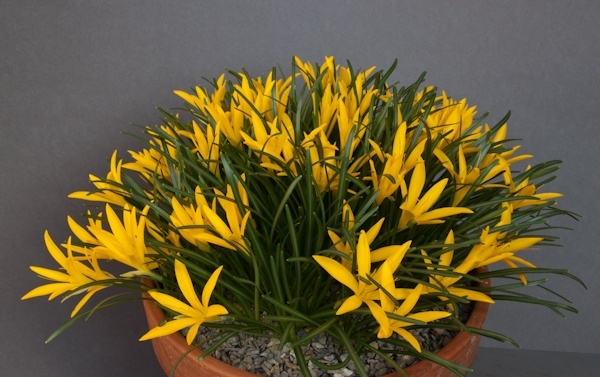
Pride of place for the best plant in the show, and awarded the Farrer Medal, a bright panful of Sternbergia sicula was shown by those doyens of the bulbous classes at our shows, Bob & Rannveig Wallis.When grown in pots sternbergias should be potted up early, in July or August if available then, along with autumn-flowering colchicums: these bulbs come into growth as soon as the temperature begins to drop, not waiting for the first rains of autumn as most crocuses do. They are not difficult to cultivate in the open garden, given freely drained soil and full sun, and are sufficiently hardy in most parts of the British Isles not to require winter protection, although this may encourage freer flowering.
Separating this entry from the runner-up, a splendid pan of Cyclamen graecum subsp. anatolicum shown by Martin Denney, was a difficult task for the judges, perhaps made slightly easier by the fact that we are now used to seeing very large cyclamen covered in flowers, whereas the sternbergia is rarely seen in such good form. Cyclamen graecum in its various forms is not really a plant for the open garden (surprising when one considers that it is often found in the wild growing near to C. hederifolium, undoubtedly the easiest cyclamen to naturalise in our gardens). But it is straightforward to grow in a pot, the best plan being to start from seed which will usually provide plants with a wide variety of foliage in terms of size, colour and markings, and a less variable range of flower variation.
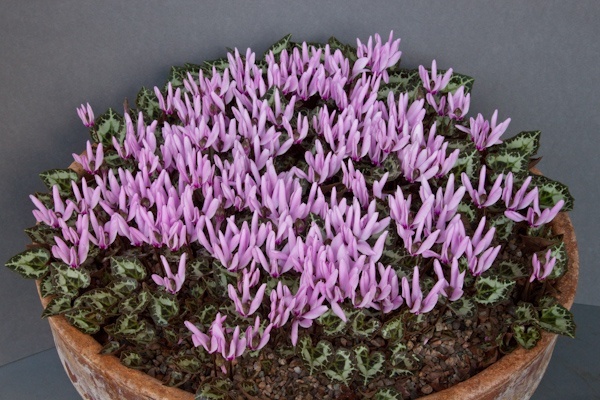
The advice to dry the corms off completely in summer, only starting to water when they start to come into growth, in my experience limits flower production. It is much better to keep the compost slightly moist throughout the period when the tubers are leafless, increasing watering when they are in full leaf. Better to under- rather than over-pot, the aim being to ensure that the soil is full of roots when the plant is in growth. Feeding is best achieved by carefully removing some of the soil from around the tuber just as it is beginning to come into growth and replacing with new.
In addition to the above, Certificates of Merit went to three other plants, Oxalis perdicaria ‘Citrino’ and Gaultheria crassa ‘John Saxton’ (which also won the Leicester Group Trophy for the best pan in cone, seed or fruit, or autumn coloured foliage), both exhibited by Keith and Rachel Lever of Aberconwy Nursery, and Colchicum alpinum shown by Jim McGregor.
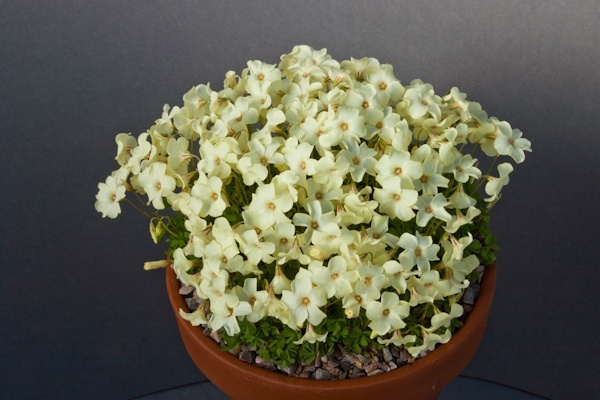
The oxalis, as the photograph shows, had flowers of a very distinctive creamy-yellow colour. Stock had been obtained a decade or more ago from Paul Cumbleton at Wisley. It has proved straightforward to grow, being one of a group that has two dormancy periods each year, starting to grow in spring but producing only leaves, then dying down for the summer, and resurrecting with foliage and flowers in the autumn. It is reputedly fully hardy, having been frozen solid in its pot in the 2010-2011 winter. When grown for exhibition it is best kept outside until just before the show as otherwise it tends to produce long-stemmed flowers over unsatisfactorily luxuriant foliage.
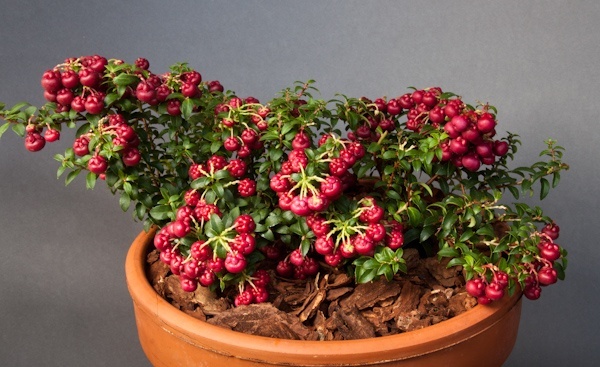
Gaultheria crassa ‘John Saxton’ commemorates one of the foremost exhibitors of ericaceous shrubs in recent times, the plant exhibited having been propagated from John’s original plant. A compact plant with attractive foliage as well as berries of an unusual very attractive tomato red, these are enhanced by very pronounced fleshy calyces of the same colour.
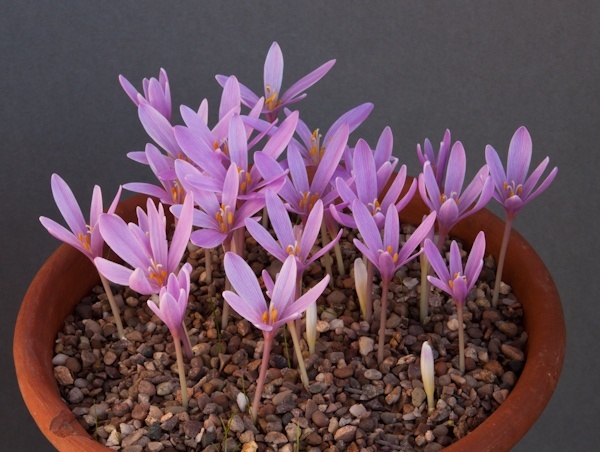
This show was notable for the range and quality of colchicumson the benches, so it had to be something special to attract the judges’ attention, in the case of the Certificate of Merit plant a very freely, evenly flowered potful of the infrequently exhibited Colchicum alpinum. The exhibitor confided that he had never flowered it as well before. I suspect few others have either, a real tribute to prolonged, careful cultivation.
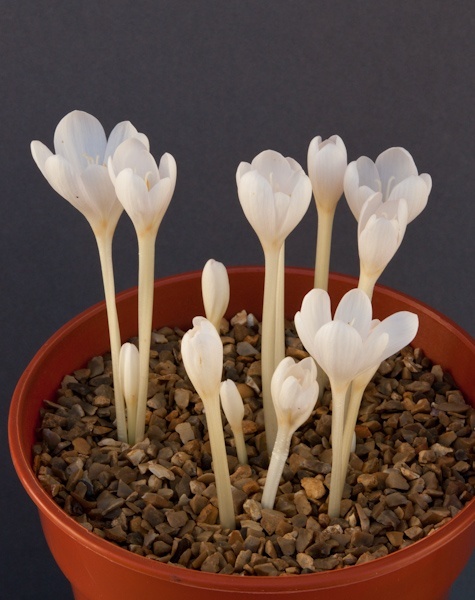
Less venerable, but nonetheless first class in every way, was a pan of C. autumnale ‘Album’ shown by Andrew Ward in the Novice Section. Not only adjudged the best plant in the section, thereby receiving the Crosshall Goblet, it also carried off the Minera Trophy for the best bulbous plant in the Novice and Intermediate Sections – well done Andrew! Other small colchicums that caught the eye were the Wallis’s C. cupanii subsp. cupanii and C. dolicantherum, and in contrast to these a fine potful of that long time garden favourite, S. speciosum ‘Album’, showing off its large, pristine snow-white flowers to perfection.
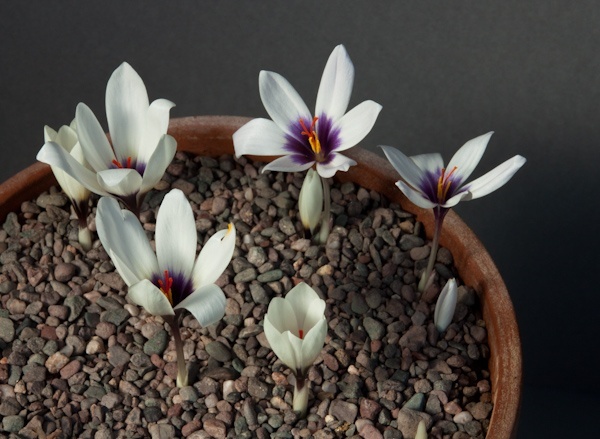
While crocuses were not the highlight of the show on this occasion there were a number of excellent exhibits, including Crocus cancellatus subsp. cancellatus, part of the winning entry from Ian Robertson in the small six-pan class that was awarded an AGS Medal. Ian also exhibited what to me is perhaps the most beautiful of all crocuses (which is saying a lot!), C. matthewii. C. goulimyi ‘Sikia Form’ shown by Ju Bramley also took the eye.
Compared with spring, and particularly summer, which provide a huge range of alliums to those wishing to cultivate this underestimated genus, all members of which are often unfairly tarnished with the same brush of uncontrollable fecundity that is rightly applied to some, autumn offers relatively few species. But to the discerning alpine gardener some of these are among the cream of autumn flowering bulbs. At this show there were excellent pans of Allium thunbergii (Bob & Rannveig Wallis), A. virgunculae (Martin Rogerson) and A. callimischon subsp. haemostictum (Ian Robertson), the first two of which are native to Japan, the last to the eastern Mediterannean. A. thunbergii has the advantage over many ornamental onions that if well grown the foliage remains green to the tips at flowering time, providing a good foil for the profuse heads of dusky pink flowers The bulbs divide readily and soon form clumps, or it can be raised quickly from seed. A. virgunculae is easily confused at first sight with A. thunbergii but it is actually quite distinct, having shorter, thinner and rounder leaves and, more importantly from a taxonomic viewpoint, a much shorter style that doesn’t extend beyond the petals, unlike A. thunbergii. Both species are good garden plants that will produce strong clumps in time in well drained but reasonably rich soil in a sunny spot.
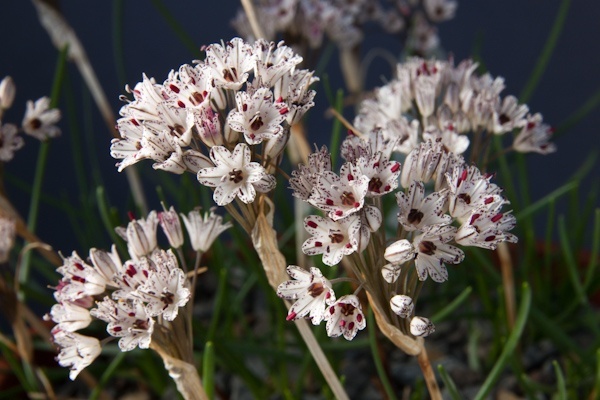
A. callimischon subsp. haemostictum is a dwarf Cretan form that flowers after the leaves have died back, on short stalks carrying clusters of white flowers enlivened by being densely spotted all over the petal surfaces with blood red. It is better grown in a pot, or perhaps a sheltered trough than in the open garden. Rather delicate, it is definitely best seen at close quarters.
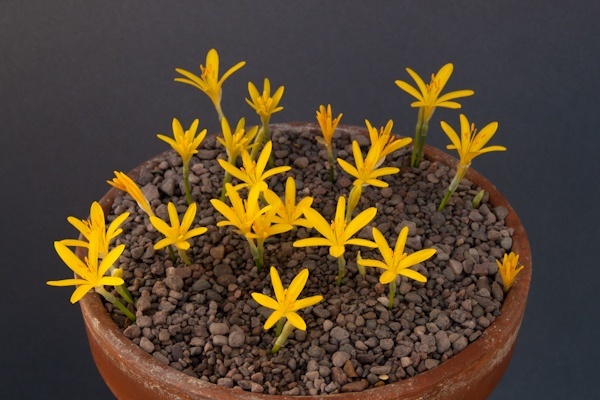
As well as the Farrer-winning Sternbergia sicula, there were other excellent exhibits of this confusing genus on the benches, representing (according to the labels) S. sicula, S. lutea and S. greuteriana [right]. As all of them apparently occur in Crete (and perhaps elsewhere in Greece) and appear to be interfertile, the questions arise as to how distinct they really are and whether they merit division into three distinct species. There was no real consensus among exhibitors on this issue, although two of the most experienced and respected bulb growers present expressed a guarded view that they probably are indeed conspecific. A research project for someone prepared to study the three ‘species’ in the wild and in cultivation is indicated.
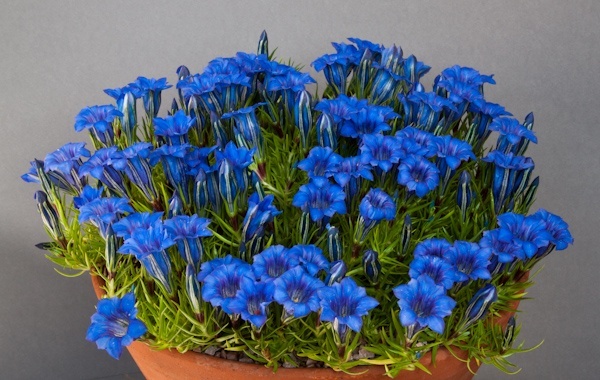
It would not be an autumn show without Asiatic gentians and there were some excellent exhibits of these, scattered across various classes, several of them from Aberconwy Nursery which has for long specialised in this popular genus. Ones that particularly caught your reporter’s eye were G. sino-ornata ‘Gorau Glas’ (‘Best Blue’) with very deep blue trumpets of good size and substance and G. farreri ‘Silken Star Group’, which glowed in the sunshine streaming through the windows of the show hall. Another lovely colour break was seen in G. ‘Braemar’, raised by Ian McNaughton of Macplants and exhibited by David Boyd.
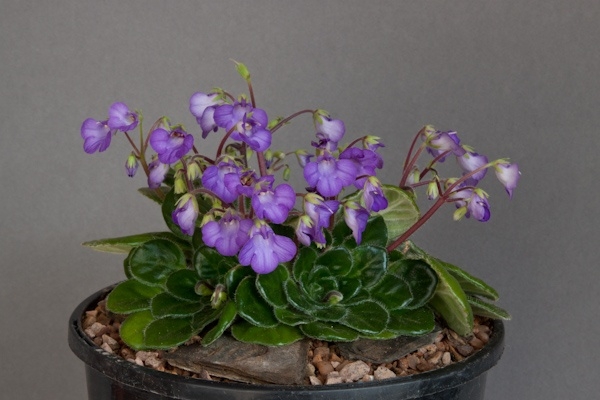
Petrocosmeas, a fascinating group of gesneriads, are becoming more popular with exhibitors as a wider range becomes available and their cultivation needs are better understood. Dave Mountfort showed three together, P. minor, P. forrestii and P. sp. aff. iodioides, enabling one to ‘compare and contrast’ at close quarters. They are not too difficult to cultivate once their natural habitat is understood: most grow on damp moss on rocks or trees at 400-1,200m in the mountains of SW China but P. forrestii (among others) has been found up to 2,200m. [Photo: P. minor]
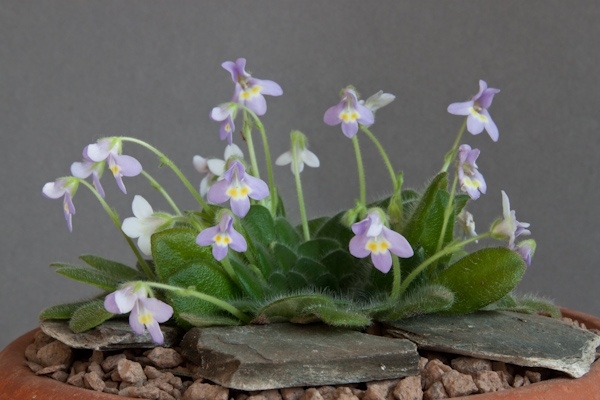
Although able to tolerate near freezing temperatures, they benefit from some protection and must not be kept too wet, especially in winter, when a combination of wet and cold will quickly kill them. Even in the growing season they require less water than one would perhaps think, due to the semi-succulent nature of their foliage. A compost of one part of peat (or substitute) to two parts of perlite or vermiculite seems satisfactory, nutrients being provided in the form of a very weak liquid feed perhaps once a month during the growing season. They must be shaded from hot sun and will grow in very deep shade, so are good candidates for a spot below the staging in the alpine house. [Photo: P. forrestii]
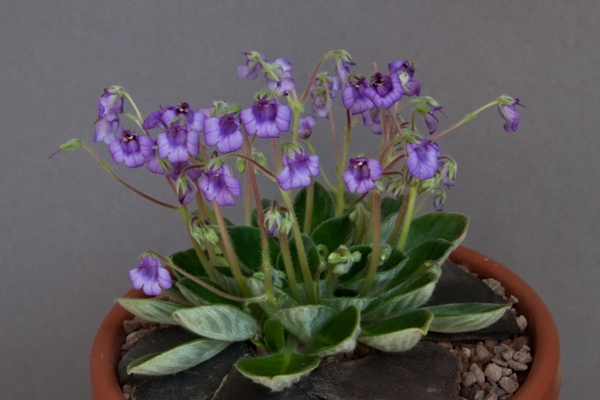
Propagation from leaf cuttings, as with other gesneriads, is quite straightforward and may be attempted at any time during the early part of the growing period. Or new plants may be raised from seed, but the seedlings are tiny early on and need careful handling to avoid them from becoming swamped by moss and liverwort. [Photo: P. sp. aff. iodioides]
Plants with outstanding autumn foliage always attract visitors’ attention. One plant, Aruncus aethusifolius, shown by Martin Rodgerson, shone out in a rich livery of autumnal shades. This Korean native, easily grown in the open ground in sun or part shade, fully deserves the Award of Garden Merit conferred by the RHS. Apart from its outstanding autumn colour, it is striking when covered with short spikes of fluffy white flowers in early summer.
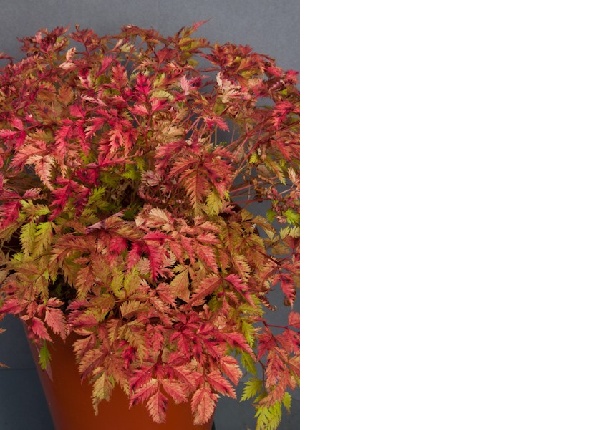
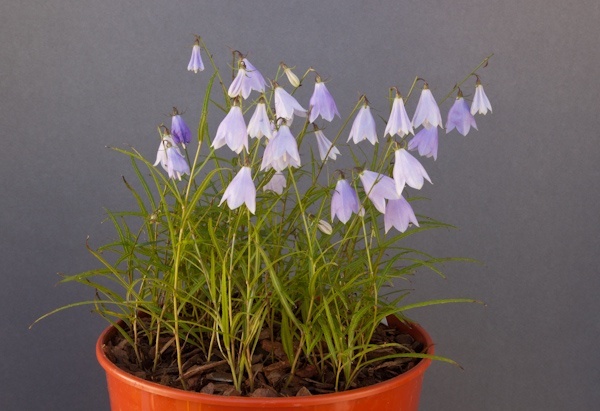
It is usually worth looking at the exhibits in the classes reserved for plants new or rare in cultivation and on this occasion an Adenophora introduced from Taiwan in 2002 by Crûg Farm Plants and exhibited by Diane Clement caught my attention. A. morrisoniensis BWJ 10008 was named for the highest mountain in Taiwan, Mt Morrison, now renamed Mt Yushan, where it grows on steep, well-drained slopes. Diane has grown it in a mix of JI3, leafmould and grit in part shade and has found it to be fully hardy in Wolverhampton, a cold part of the country. This being the case, I hope we shall see a good deal more of it in future.
